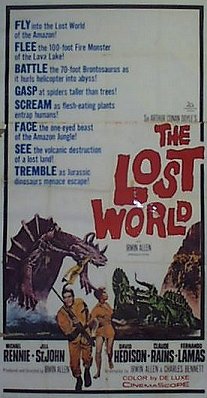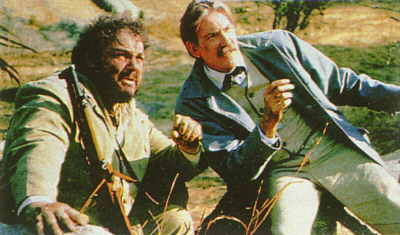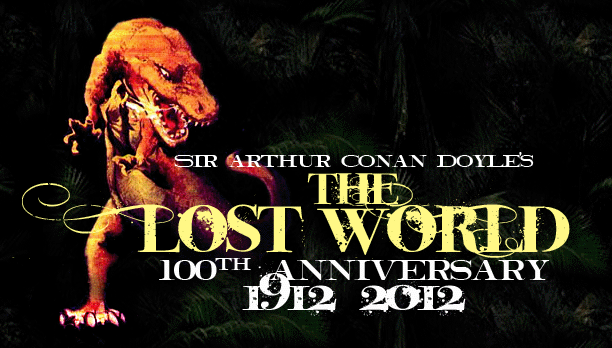|
How the Mighty Fall...
As if profiting off of the name of Willis O'Brien wasn't enough for the 1960 version of The Lost World, it misused yet another fantastic personality.
As you may note from the two 1960 film posters to the right, the name of Claude Rains is well down the list of stars. Playing Challenger, Rains was a classic genre actor who's first great role was that of the title character in Universal's The Invisible Man. Here, Rains ends up behind Michael Rennie (The Day the Earth Stood Still), David Hedison (The Fly), and Jill St. John (Playboy magazine).
The shame of it all.
Film Links
- Classic Science Fiction - The Lost World
- Fox's official 1960 film site, from their Science Fiction Classics collection video rerelease. Includes video clips.
- The Lost World (1960)
- The Dino-Source's 1960 film resource.
- The Lost World (1960)
- Review from the hilarious And You Call Yourself A Scientist! mad-science film website.
- The Lost World Movie Review
- The Movie Club uses reverse psychology in a review of the 1960 version... A version that's more fun to mock than to watch.
- The Lost World (1992) and Return to the Lost World (1992)
- The Dino-Source's LW resource.
The Lost World: Jurassic Park
Genre, homage or literary theft? We chroncile the controversy over the title of the Jurassic Park sequel.
Read it here.
|
The two decades following the end of the Second World War – with the advent of atomic power, the Space Race and the Cold War – was a golden age for Science Fiction. The climate of limitless possibility mixed with xenophobia and apocalyptic anxiety in a future that had arrived proved incredibly fertile for drive-in theatre films and television shows in newfangled colour. This is was the era of classic rocketships and the original Star Trek. The times were no less kind to dinosaur films, which tagged along for impending atomic horror. Through the 50's and 60's, there was one proper adaptation of Conan Doyle's tale, but also two very loosely inspired films.
- Two Lost Worlds by Norman Dawn (Dir.), Sterling Productions (1951)
- Figuring that two lost worlds were better than one, this United Artists feature begins with a 19th century crew besieged by pirates in and around Australia. Escaping the pirates, our protagonists find themselves stranded on the second lost world, being an island populated by the durable stock footage of wrestling lizards from 1940’s One Million B.C. Comprising the sole “dinosaur” activity in this and countless other films (including several of those mentioned above), this iconic imagery popularized the use of cinematographically enlarged lizards in paper frills just as it also helped provoke a ban on animal cruelty in films.
Review by Cory Gross, excerpted from an upcoming paper to be published in a centenary edition of the novel.
- The Lost Continent by Sam Newfield (Dir.), Lippert Pictures (1951)
- Given that Two Lost Worlds was unaccomplished in its attempt to surpass Conan Doyle’s tale, the ante was upped by placing living dinosaurs on a hidden plateau on its own island in Lost Continent. Making use of stock footage from Rocketship X-M instead of One Million B.C., this film begins with the crash of a high-tech space ship on a heretofore unknown island. A troupe led by Cesar Romero and including native girl Acquanetta tracks the ship down to a plateau, where they find it protected by living dinosaurs. Hijinks ensue until the island self-destructs. Recognizing the fault of relying on lizards in frills, Lost Continent makes substantial use of stop-motion. The dinosaurs, however, are disastrously adorable, which takes away from their threatening character.
Review by Cory Gross, excerpted from an upcoming paper to be published in a centenary edition of the novel.
- The Lost World by Irwin Allen (Dir.), Irwin Allen Productions (1960)
 This 1960 version, which updated the setting to the swinging 60's and downplayed the exotic adventure by reaching the plateau via helecopter and supersonic jet, starred Claude Rains as
Challenger, playing opposite a bunch of really big lizards
in paper frills, man-eating trees, monster spiders, Michael Rennie, Jill St.John's breasts, David Hedison, and a "fire beast who guards a king's ransom in treasure" (to quote the original trailer). This 1960 version, which updated the setting to the swinging 60's and downplayed the exotic adventure by reaching the plateau via helecopter and supersonic jet, starred Claude Rains as
Challenger, playing opposite a bunch of really big lizards
in paper frills, man-eating trees, monster spiders, Michael Rennie, Jill St.John's breasts, David Hedison, and a "fire beast who guards a king's ransom in treasure" (to quote the original trailer).
Somewhat okay, if you're into cheesy 60's B-movies and paper frilled lizards... No, actually I lie. It's not. The production is so plagued with errors and cliches as to make it little good for anything but heckling. Why does Roxton seem to be incapable of telling the difference between night and day? Is it because they whole thing was obviously filmed at high noon? Does the swarthy, cowardly ethnic die from his own greed? You better believe it. Who thought it would be a good idea to let a woefully inequiped and poodle-toting Jill go to the plateau, rather than leave her at the cabana?
Willis O'Brien was brought in as a technical director though, but unfortunately, the production didn't quite have as much use for him as it did for his name. The pioneer of stop motion animation was reduced to watching over trick photography as a trussed up monitor lizard and alligator were made to fight... Graphically... with bloodshed... real blood... and a long distance fall that probably killed them both...
Review by Cory Gross.
The next wave of Lost World adaptations would come in the 1990's in the wake of the unprecedented popularity of 1993's Jurassic Park. In fact, it's almost down exactly to the dates: adaptations were released in 1992 to coincide with Jurassic Park, anotehr in 1998 to conincide with its sequel, and another in 2005 to coincide with Peter Jackson's remake of King Kong.
The appeal is understandable, of course. Not that it has anything to do with Conan Doyle's novel being a litrary classic of ripping adventure, which it is. Instead, the novel is public domain, meaning that fly-by-night producers could churn out a dinosaur film on the cheap without having to pay for expensive liscences. In the process, it's generally pretty stomach-turning to see a great catalyst of dinosaur fiction reduced to a glaring cataract.
And as if to add insult to injury, Jurassic Park’s author, Michael Crichton, even went so far as to title his sequel The Lost World. Attempting to explain himself, Crichton only poured more salt on the wound by saying that the title is “a reference to Conan Doyle, one of his more pulpy stories. It's a Professor Challenger story, and it's actually not a very good book, but it's a wonderful title, and it's about an expedition to a place where there are dinosaurs." While one may be suspicious of Crichton’s motives or tastes in literature, at least Spielberg’s The Lost World: Jurassic Park showed proper homage to the films that came before it, like The Lost World, the original King Kong and Godzilla.
- The Lost World and Return to the Lost World by Timothy Bond (Dir.), Harmony Gold (1992).
- This version and its sequel starred a pair of fantastic actors, John Rhys-Davies and David Warner, as Challenger and Summerlee respectively. There are few actors so perfectly suited to play Challenger as Rhys-Davies, who is perhaps most famous for playing Sallah in the Indiana Jones series. Warner has practically made a career out of playing condescending intellectuals, including the Klingon chancellor in Star Trek VI, genocidal maniac Ra’s Al Ghul in the Batman and Superman cartoons, Jack the Ripper in Time After Time, and the main villain in Tron. He also had the privilege of playing Sir Arthur Conan Doyle himself in 1998’s Houdini. Rounding out the cast were a pre-Will and Grace Eric McCormack as Malone, Nathania Stanford as tribeswoman Malu, Darren Peter Mercer as newspaper boy Jim, and Tamara Gorski as the suffragette photographer Jenny Nielson.
While the cast was off to a good start, they were hampered first by a poor budget and second by a poor script. While the film was produced in the exotic locales of Harrare, Zimbabwe, the special effects betray something of a shoestring. British special effects artist Peter Parks was out of his element with his mechanical dinosaurs that more closely resembled Muppets than monsters.
Where previous cinematic Lost Worlds have been “needlessly fussed up with the love element” (which weren’t lacking in this version either), the 1992 version was needlessly fussed up with a politically correct slant that turned an otherwise ripping adventure into a fairly tedious sermon. Roxton the hunter was long-gone, and in his place were wizened natives and liberated women touting the virtues of environmentalism, along with a token child to appeal to the juvenile demographic. In the double-billed Return to the Lost World made and released the same year, the Challenger Expedition goes back to Africa to save it from evil oil prospectors.
Review by Cory Gross, excerpted from an upcoming paper to be published in a centenary edition of the novel.
- Sir Arthur Conan Doyle's The Lost World by Bob Keen (Dir.), Trimark Pictures (1998)
- Thankfully, a strong cast makes 1992’s ventures tolerable. The same cannot be said for the 1998 version starring chronic B-movie actor Patrick Bergin as Challenger, Jayne Heitmeyer channeling the spirit of Bessie Love as scientist Amanda White, David Neman as the villainous John Roxton, Michael Sinelnikoff as Summerlee and Julian Casey as Malone. Shifting the plateau to Mongolia this time, the 1998 version begins with a grizzled Malone throwing his notes off the cliff in the hopes that someone won’t notice that merciless plagiarism of The Land That Time Forgot. It ends with sole survivors Challenger and White disavowing the existence of the plateau and, without a doubt, the film itself.
Review by Cory Gross, excerpted from an upcoming paper to be published in a centenary edition of the novel.
- King of the Lost World by Leigh Slawner (Dir.), The Asylum (2005)
- Babylon 5's Bruce Boxleitner collects a paycheque in this direct-to-video feature advertizing itself as “the epic story that inspired King Kong and Jurassic Park” in the vain hope that no one would notice that it's using the credentials of Conan Doyle’s story to make a poorly-executed bootleg of Jurassic Park and Peter Jackson’s King Kong sound better than it really is.
Review by Cory Gross.

John Rhys-Davies and David Warner in 1992's The Lost World.
|


